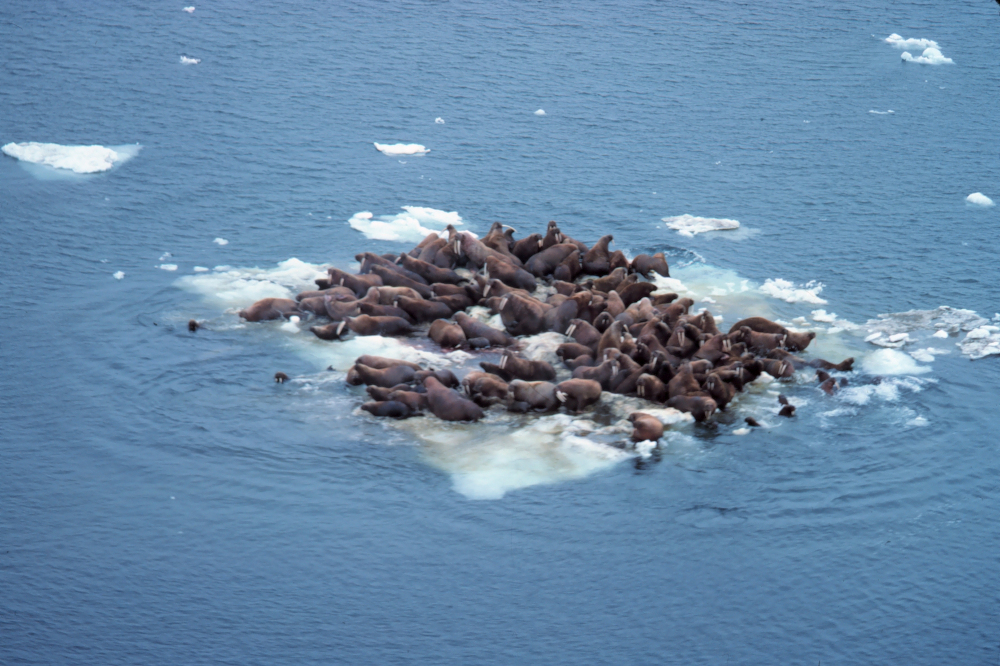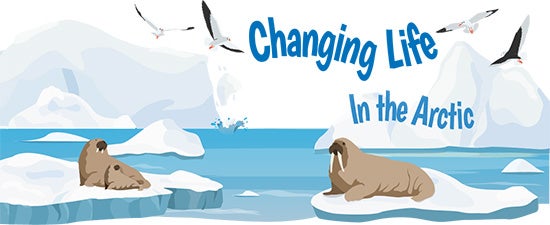
Illustrated by: Megan Joyce
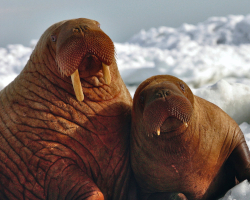
The clock ticks toward midnight, but the sun has only just dipped below the horizon. A stream of golden light is still shining across an ice floe. This particular ice floe, or large piece of floating sea ice, carries a pod of walrus through Arctic waters.
Otis is a walrus pup born on that ice floe in late spring in the Chukchi Sea, located between the northern coasts of Russia and Alaska. The walrus is a keystone species in the Arctic ecosystem, so Otis has an important role to play in the food web. Walrus move in herds on huge flat pieces of Arctic sea ice. Sometimes there can be thousands of walruses on one piece of ice. These floes move with the wind and ocean currents. Walruses hitch a ride on these drifting ice floes to find new feeding locations.
Walrus Appetite
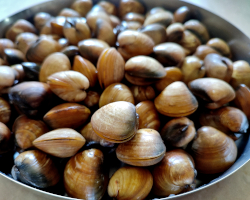
Walrus pups, like Otis, who are still growing, don’t have to eat nearly as much as full grown adults. In one single feeding session adult walruses can eat 3,000 to 6,000 clams. This weighs between 300 and 600 pounds, which on the low end is about the weight of a full size refrigerator!
To find clams, walruses dive to shallow sea floors and search with their sensitive whiskers. Once food is found, walruses seal their lips to the clam's shell and quickly pull their tongues back in their mouths. This creates a vacuum, sucking the clam meat out of the shell.
During the winter, Otis doesn't need to eat as much and he can stay huddled with his family for warmth and protection. Cold winter weather causes walrus heart rates and metabolisms to slow down. As the temperatures become warmer, Otis's heart rate will again adjust to the changing weather.
Arctic Changes
Each winter season seems to be shorter than the last, making it harder to find ice floes to rest on. For twenty years Otis swims, forages, and drifts through the Arctic on sea ice. At this point, he has lived a long time, but each year gets a bit harder and each winter a bit shorter.
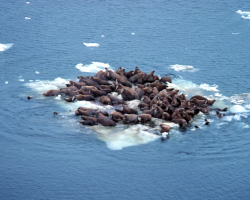
There is less sea ice, because human activity is causing the climate to change faster than at any time in Earth’s history. We are releasing greenhouse gases, including carbon dioxide and methane, into the atmosphere. These gases trap heat in our atmosphere, just like a greenhouse traps heat inside of it.
There isn’t just one thing people are doing that contributes to climate change. Every time you drive in a car, heat or cool your home, eat food shipped from far away, or buy something mass produced, greenhouse gases are emitted to make that possible. Now multiply that by billions of people and millions of companies. That's a lot of extra greenhouse gases trapping heat in the atmosphere.
The Arctic is warming faster than the rest of the planet, melting the ice floes that Otis depends on. The loss of sea ice means the walrus can’t drift to new feeding grounds. Also, some of that extra carbon dioxide we release into the atmosphere mixes into the ocean, causing ocean acidification. This creates a poor environment for sea life, including clams, the walrus’ main food source.
Otis dives all day, and while the acidic waters don’t hurt his tough skin, it causes clams to weaken and possibly die. The clams that survive are smaller and less nutritious, because it takes them more energy to make their shells. Without lots of clams to keep him full, Otis has to look for other food sources.
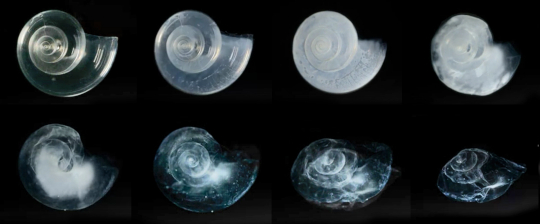
Ocean acidification is just one way that humans are disrupting the Arctic food chain. Human activity in the Arctic, like oil drilling, can lead to dangerous spills that hurt wildlife. One way oil spills harm the ecosystem is by sinking down to the ocean floor. It covers the clam beds that walrus eat from, and stresses out other animals.
The oil stays in the environment for a long time, as oil slicks on top of the water, on the sea bed, and as tiny particles in the water. Oil spill events do not only affect the walrus; many other Arctic species are impacted by oil spills as well. The toxins from the oil linger in the ice and water, so impact the near-surface food webs as well.
Even though the Arctic might be far away from your home you still play a role in its health. Many types of life rely on the Arctic ecosystem to survive, but humans are putting their habitat in danger. Small changes in your actions and big changes that we can make together can reduce climate change. These things will help protect the Arctic ecosystem and our planet.
This section of Ask A Biologist is based upon work supported by the National Science Foundation under Grant No. 1928235.
Additional Images from Wikimedia Commons.
Read more about: Changing Life in the Arctic
Bibliographic details:
- Article: Changing Life in the Arctic
- Author(s): Emma Goethe, Cecilia Knaggs, Leah Shaffer
- Publisher: Arizona State University School of Life Sciences Ask A Biologist
- Site name: ASU - Ask A Biologist
- Date published: 27 Jul, 2022
- Date accessed: 21 May, 2025
- Link: https://askabiologist.asu.edu/explore/arctic-ecology
APA Style
Emma Goethe, Cecilia Knaggs, Leah Shaffer. (Wed, 07/27/2022 - 09:36). Changing Life in the Arctic. ASU - Ask A Biologist. Retrieved from https://askabiologist.asu.edu/explore/arctic-ecology
Chicago Manual of Style
Emma Goethe, Cecilia Knaggs, Leah Shaffer. "Changing Life in the Arctic". ASU - Ask A Biologist. 27 Jul 2022. https://askabiologist.asu.edu/explore/arctic-ecology
MLA 2017 Style
Emma Goethe, Cecilia Knaggs, Leah Shaffer. "Changing Life in the Arctic". ASU - Ask A Biologist. 27 Jul 2022. ASU - Ask A Biologist, Web. https://askabiologist.asu.edu/explore/arctic-ecology

A 1996 oil spill near Rhode Island killed more than 400,000 kilograms of clams. It also hurt many other animals, including those that eat clams. Image by NOAA.
Learn how changes to the land and ice in the Arctic affect the whole food web with our game EcoChains: Arctic Futures.
Be Part of
Ask A Biologist
By volunteering, or simply sending us feedback on the site. Scientists, teachers, writers, illustrators, and translators are all important to the program. If you are interested in helping with the website we have a Volunteers page to get the process started.



